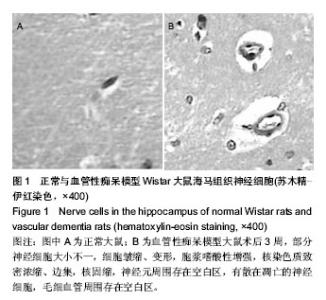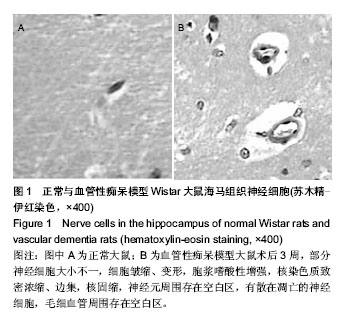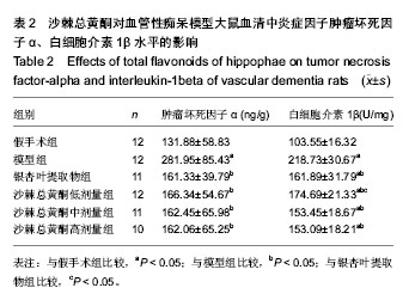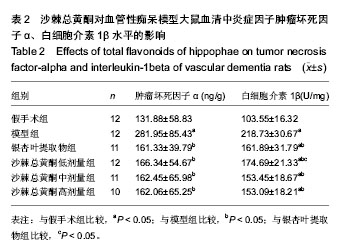| [1] Korczyn AD,Vakhapova V,Grinberg LT.Vascular dementia.J Neurol Sci.2012;322:2-10.
[2] Seitz DP,Adunuri N,Gill SS, Antidepressants for agitation and psychosis in dementia.Cochrane Database Syst Rev.2011; (2):CD008191.
[3] Lee AY.Vascular dementia.Chonnam Med J.2011;47(2):66-71.
[4] Sharma B,Singh N.Attenuation of vascular dementia by sodium butyrate in streptozotocin diabetic rats. Psychopharmacology (Berl).2011;215(4):677-687.
[5] 李焰生.血管性认知功能损害研究值得重视的问题[J].中国实用内科杂志,2010,30(10):891-894.
[6] Wimo A,Jönsson L,Bond J,et al.The worldwird economic impact of dementia 2010. Alzheimers Dement.2013;9(1):1-11.
[7] 张楠.血管性痴呆的治疗进展[J].中国全科医学,2013,16(12): 4239-4241.
[8] 曲艳吉,卓琳,王华丽,等.1980-2011年中国社区55岁及以上人群中血管性痴呆流行病学的Meta分析[J].中国卒中杂志,2013,8(7): 533-543.
[9] 钱釆韵.血管性痴呆与血管性认知功能障碍[J].中国医学科学院学报,2004,26(2):198-200.
[10] Ford GA,Bryant CA,Mangoni AA,et al.Stroke,dementia,and drug delivery.Br J Clin Pharmacol.2004;57(1):15-26.
[11] 蔺心敬,胡长林,李吕力,等.血管性痴呆发生机制的研究[J].脑与神经疾病杂志,2003,11(4):235-236.
[12] 赵勇,崔淑芳,汤球.血管性痴呆动物模型研究进展[J].上海实验动物科学,2005,25(1):54-56.
[13] Jiwa NS,Garrard P,Hainsworth AH.Experimental models of vascular dementia and vascular cognitive impairment: a systematic review.J Neurol Sci.2010;299(1-2):188-192.
[14] 黄文革,郭芬芬,刘慰华,等.血管性痴呆动物模型制作方法的改良[J].中国比较医学杂志,2011,21(5):49-52.
[15] Wang BS,Wang H,Song YY,et al.Effectiveness of standardized ginkgo biloba extract on cognitive symptoms of dementia with a sixmonth treatment: a bivariate random effect meta-analysis. Pharmacopsychiatry.2010;43(3):86-91.
[16] Weinmann S,Roll S,Schwarzbach C.Effects of Ginkgo biloba in dementia: systematic review and meta-analysis.BMC Geriatr. 2010;10:14.
[17] 程嘉艺,滕丹.沙棘总黄酮对血管内皮细胞保护作用及机制研究[J].中国中西医结合杂志,2011,31(3):355-356
[18] 刘风云.沙棘总黄酮的药理研究[J].中药材,2004,27(2):145-146.
[19] 廖晓阳,张茂顺,王伟文,等.醋柳黄酮对原发性高血压患者一氧化氮、内皮素的影响[J].华西医学,2005,20(2):247-248
[20] 古丽米热•阿不都热依木,依巴代提•托乎提,热娜•卡斯木,等.沙棘总黄酮对阿霉素所致大鼠心肌梗塞和脂质过氧化保护作用的研究[J].新疆医科大学学报,2010,33(4):383-385
[21] Castellanos M, Castiuo T, Garcia MM, et al. Inflammation mediated damage in progressing lacunar infarctions: a potential therapeutic target.Stroke.2002;33(4):982-987.
[22] Baskys A,Hou AC.Vascular dementia:pharmacological treatment approaches and perspectives.Clin Interv Aging. 2007;2(3):327-335.
[23] Grantham C,Geerts H.The rationale behind cholinergic drug treatment for dementia related to cerebrovascular disease.J Neurol Sci.2002;203-204:131-136.
[24] 钟萍,吴丹红,孙京华.小檗碱对血管性痴呆大鼠海马IL-1β、IL-8、TNF-α表达水平的影响[J].卒中与神经疾病,2013,20(1):16-19.
[25] Bateman GA,Levi CR,Schofield P,et al.Quantitative measurement of cerebral haemodynamics in early vascular dementia and Alzheimer’s disease.J Clin Neurosci.2006; 13(5):563-568.
[26] de la Torre JC.Vascular basis of Alzheimer’s pathogenesis.Ann N Y Acad Sci.2002;977:196-215.
[27] Farkas E,Luiten PG.Cerebral microvascular pathology in aging and Alzheimer’s disease.Prog Neurobiol.2001; 64(6):575-611.
[28] Matsuda H.Cerebral blood flow and metabolic abnormalities in Alzheimer’s disease.Ann Nucl Med.2001;15(2):85-92.
[29] Borroni B,Anchisi D,Paghera B,et al.Combined 99mTc-ECD SPECT and neuropsychological studies in MCI for the assessment of conversion to AD.Neurobiol Aging.2006; 27(1):24-31.
[30] Hirao K,Ohnishi T,Hirata Y,et al.The prediction of rapid conversion to Alzheimer’s disease in mild cognitive impairment using regional cerebral blood flow SPECT. Neuroimage.2005;28(4):1014-1021.
[31] Farkas E,Luiten PG,Bari F.Permanent,bilateral common carotidartery occlusion in the rat:a model for chronic cerebral hypoperfusionrelated neurodegenerative diseases.Brain Res Rev.2007;54(1):162-180.
[32] 唐启盛,黄启福,郭建文.高脂血症大鼠缺血再灌流诱发行为学障碍模型的实验研究[J].北京中医药大学学报,1997,20(5):34-36.
[33] 尹军祥,田金洲,黄启福,等.MCAO拟血管性痴呆大鼠模型的建立[J].中国病理生理杂志,2003,19(8):1144-1147.
[34] 毛峥嵘.血管性痴呆的研究概况[J].河南中医,2001,21(4):76.
[35] 崔尧元,史玉泉.大鼠局灶性脑梗塞后神经行为和记忆障碍的实验研究[J].中国行为医学科学,1995,4(3):123.
[36] 查运红,梅元武,黄敬,等.老年期痴呆大鼠模型的制备及其神经行为学研究[J].中华物理医学与康复杂志,2005,27(11):641-644.
[37] Jiwa NS,Garrard P,Hainsworth AH.Experimental models of vascular dementia and vascular cognitive impairment:a systematic review.J Neurochem.2010;115(4):814-828.
[38] Tsuchiya M,Sako K,Yura S,et al.Cerebral blood flow and hi -stopathological changes following permanent bilateral carotid artery ligation in Wistar rats.Exp Brain Res.1992;89(1):87-92.
[39] 孙莉,吴江,王守春,等.血管性痴呆大鼠脑血流量及细胞凋亡的研究[J].中华老年心脑血管病杂志,2001,3(6):409-411.
[40] Otori T,Katsumata T,Muramatsu H,et al.Long-term measurement of cerebral blood flow and metabolism in a rat chronic hypoperfusion model.Clin Exp Pharmacol Physiol. 2003; 30(4):266-272.
[41] Tanaka K,Wada N,Ogawa N.Chronic cerebral hypoperfusion induces transient reversible monoaminergic changes in the rat brain[J].Neurochem Res.2000;25(2):313-320.
[42] 景玉宏,宋焱峰,王子仁.血管痴呆大鼠星形胶质细胞增生与TNF-α的表达[J].中华神经医学杂志,2004,3(6):418.
[43] Spielmann S,Kerner T,Athlers O,et al.Early detection of increased tumour necrosis factor alpha(TNF-α)and soluble TNF receptor protein plasma levels after trauma reveals association with the clinical course.Acta Anaesth Scand. 2001;45(3):364.
[44] 刘治军,李林,叶翠飞,等.二苯乙烯苷对脑缺血啮齿动物脑NMDA受体及细胞内钙离子的影响[J].中国药理学报,2003,19(10): 1112.
[45] 王华,徐志州,高向东.沙棘总黄酮对改善神经细胞损伤的作用[J].中国生化药物杂志,2007,28(3):158-160.
[46] 胡久略,贺又舜,张超云,等.补肾醒脑方对血管性痴呆大鼠血管内皮生长因子、白介素-1β和肿瘤坏死因子-α表达的影响[J].中国实验方剂学杂志,2011,17(5):190-192.
[47] 石英辉,郭炳彦,韩瑞,等.姜黄素胶囊对慢性心力衰竭患者TNF-α、脂联素水平以及心功能的影响[J].现代中西医结合杂志,2010,19(4):395.
[48] 孙洁芸,余天平,张雄,等.血管性痴呆大鼠模型中海马的组织病理学和超微结构变化[J].重庆医科大学学报,2013,38(3):225-229.
[49] 张洪,章军建.血管性痴呆的药物预防和治疗进展[J].中华临床医师杂志(电子版).2013,7(5):2149-2151. |





